Previous Exhibitions
creative environment.
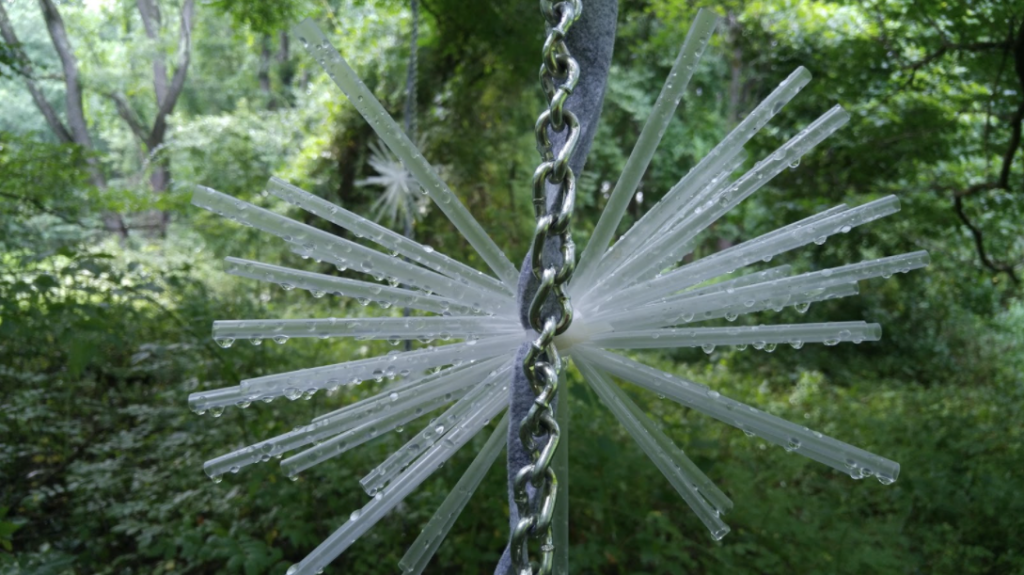
In 1999, the Schuylkill Center had just completed its first 10-year master plan, with the recommendation that the Center diversify its programming to bring in new audiences. With that goal in mind, renowned curator Mary Salvante approached the executive director and proposed an art program as a strategy for attracting new visitors, recognizing the rich potential of the Schuylkill Center site as inspiration for artists, and art as a pathway to support the organization’s mission. The program began at a small scale with exhibitions in the Visitor Center, while putting together grant applications for funding of larger initiatives such as an artists-in-residence program and outdoor temporary art exhibitions.
Over time, the environmental art program has grown to be one of the Schuylkill Center’s four core program areas, and one of the most unique and ambitious art programs based at a nature center nationally. The goals of the program have expanded to align not only with the Schuylkill Center’s educational goals, but its land stewardship goals.
In 2012, we built a larger, more defined gallery space to allow for more ambitious indoor exhibitions. More than 350 artists have participated in exhibitions and projects since the program’s inception. Today, the Schuylkill Center for Environmental Education’s Environmental Art program provides opportunities for artists and community members to innovate and interpret modern environmental concerns.
Continue reading to explore the history of art here at the Center, or visit our current exhibition page to read more about what’s currently on display.
Past Projects
Fire Season
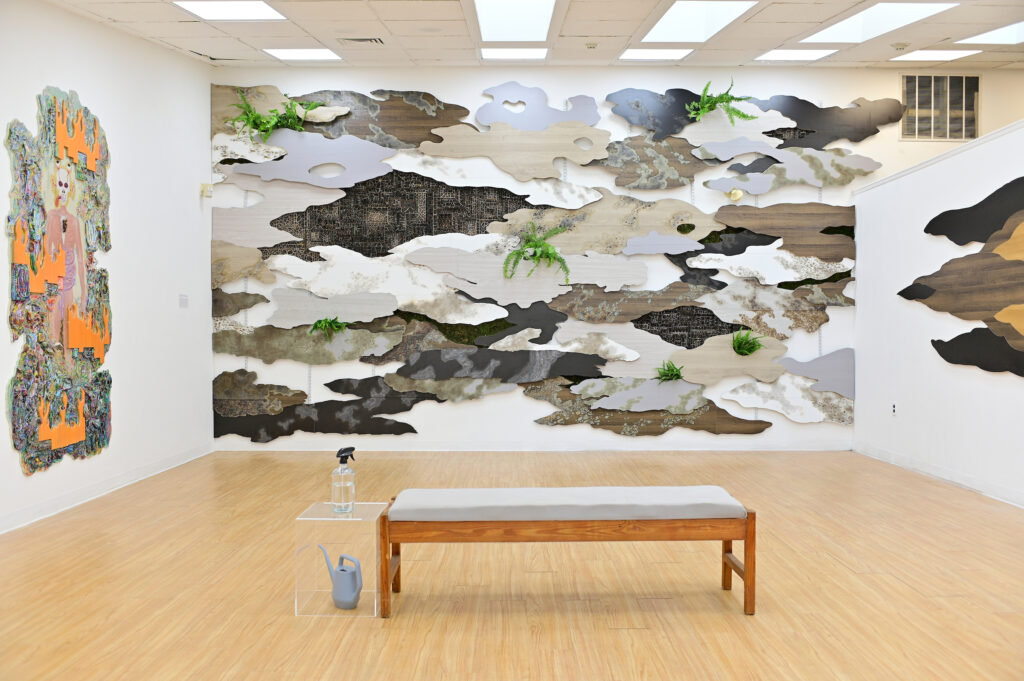
Photo: Bastiaan_Slabbers Fire Season
October 12, 2024 – January 17, 2025Fire Season brings together artists attuned to the intimate relationship between death and life and who embrace fire as an essential element in this process of renewal; after a forest burns it supports a vast diversity of life. They contend with our world’s present imbalance and excess of fire and offer material and spiritual perspectives on the planet’s eventual rebirth into its next unfathomable formation. Narendra Haynes’ work uses synthetic and processed construction materials to create landscapes from deliberate burnings. This work is in conversation with Ye Qin Zhu’s relief paintings that breathe new life into discarded materials and mundane objects by weaving them into broader mythological scenes of creation.
Fire Season is co-curated by Kristina Murray and Ilya Blender.
Fire Season and Pining Away: Eco-Readings Outdoors have been made possible by a grant from the Joseph Robert Foundation.
Seed Stories: A Celebration of Land-based Creators
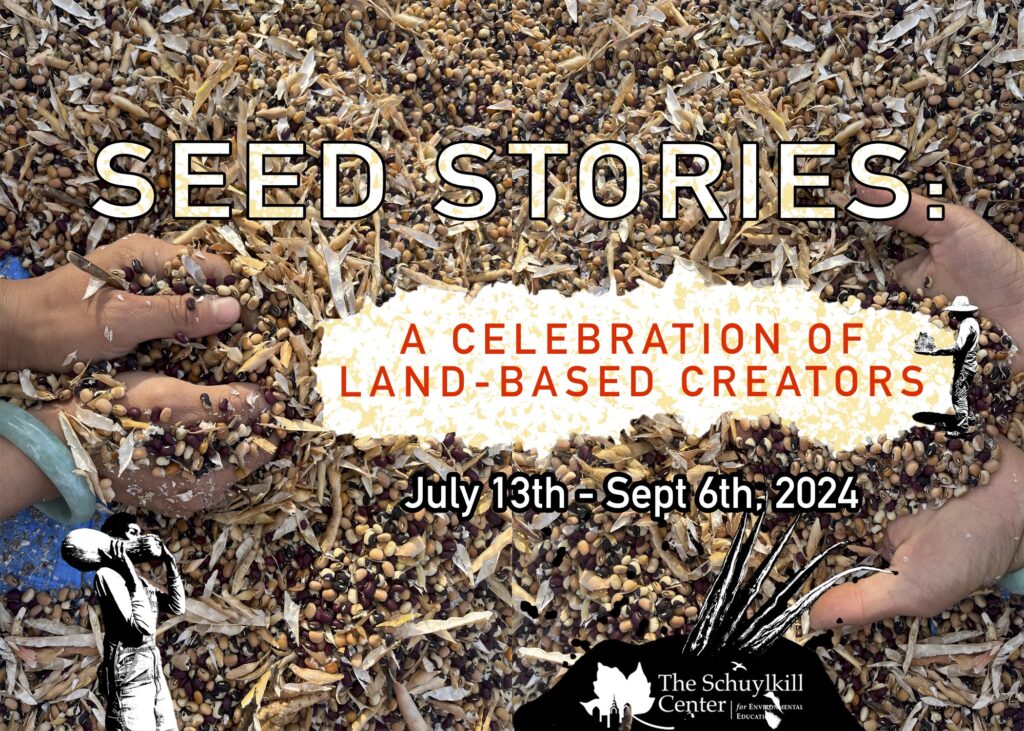
July 13 – Sept 6, 2024
Seed Stories brings together several of Philadelphia’s seedkeepers to share the artistic practices they tend to alongside their gardens. Seedkeeping, a practice of growing plants for seed harvesting, sustains genetic biodiversity and carries forward ancestral wisdom, ensuring the legacy of these plants and their communities for future generations. These artists preserve, craft, and build through a variety of mediums, including ceramics, embroidery, cyanotypes, paintings, and printmaking. Seedkeepers are more than gardeners; they are stewards of the future. Through their artistic and land practices, they honor ancestral traditions, cultivate resilience, and sow the seeds of connection.
Curated by Ilya Blender and Kristina Murray with support from Jayla Clark.
Slow-Burning Rapture
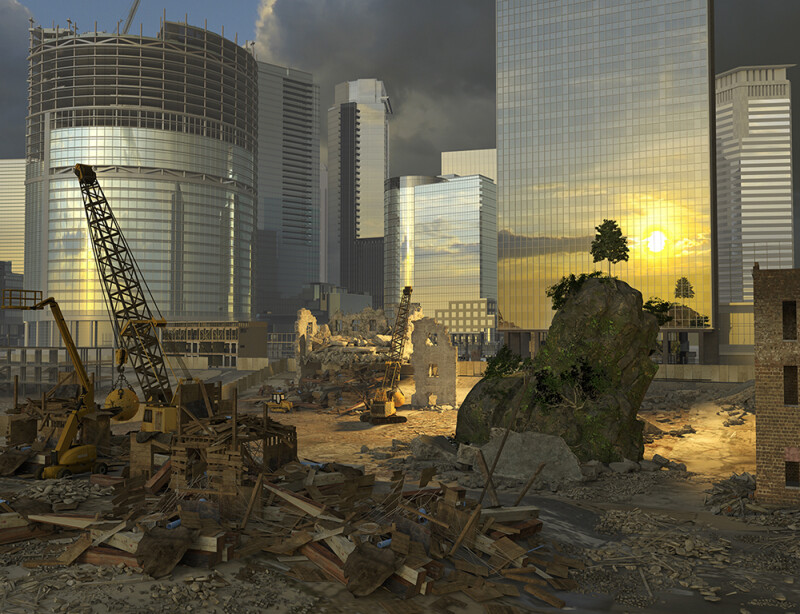
February 9 – May 3, 2024
Throughout history, humans have crafted stories which grapple with our ever-changing relationships to the natural world. Artists, too, create, dissect and disseminate work which makes sense of our ecological past, present and future. In Slow-Burning Rapture, artists construct personal and communal tales, interrogate nationalist epics and envision post-natural topographies through material play, building multifaceted myths which forecast our human-nature relationship in the Anthropocene
To achieve this end, electronic waste is woven together to create a river-like installation (Talia Greene); a beloved Finnish myth is theatrically brought to life through styrofoam, wood and salt (Sarah Peoples); animation software and drone footage meld to create a new social model in the form of a cityscape (Tim Portlock); 3D modeling is used to generate colorful, imagined rocks and minerals to “power” our cell phones (JULM Studios); and a sonic broadcast set in the near-distant future envelops the gallery space in sound (Jordan Deal). The artists in this exhibition employ satire, reverence, trepidation and humor to make their point: that as our planet evolves and our landscapes change, our collective stories will continue to resonate. With vast references from mythology to mysticism and Afrofuturism to worldbuilding, and with nods to beloved creators like Octavia Butler and Joseph Campbell, each artist’s visual and sensory language plays a part in helping unravel the complexities of an altered world.
This exhibition is supported by the National Wildlife Federation and the Alliance for Watershed Education’s Art Work Group. The Schuylkill Center Environmental Art Department is supported by the Pennsylvania Council on the Arts.
The Bird Ethic
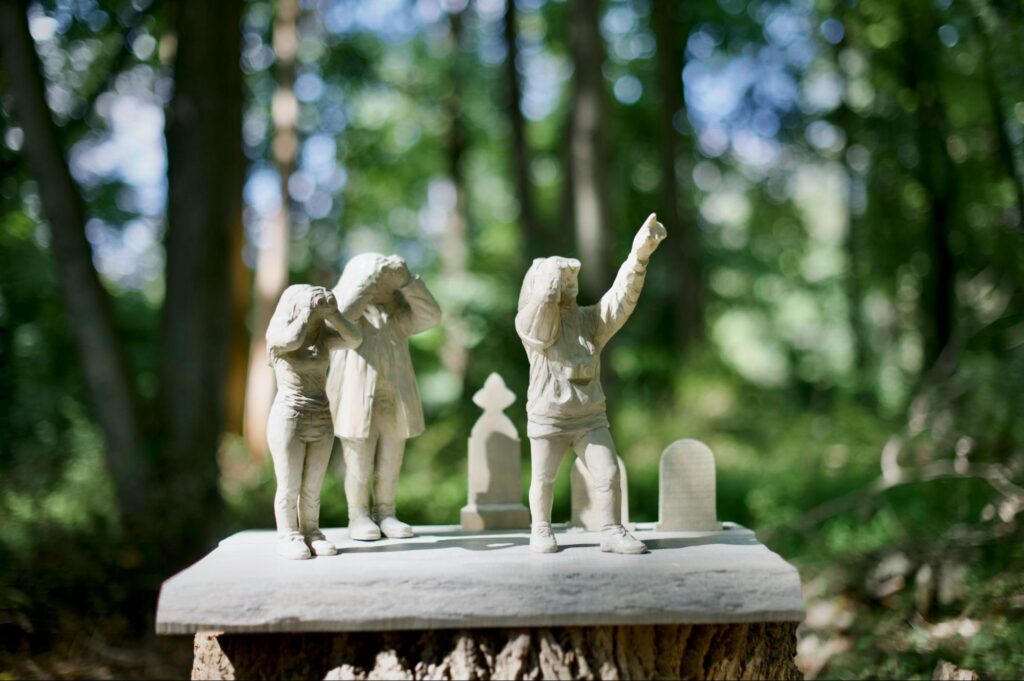
LandLab artist-in-residence Susan Hagen offers a series of diorama-inspired outdoor sculptures capturing historical moments in bird conservation, bird science, and humankind’s impact on bird populations. Constructed from mixed media including reclaimed timber from the Schuylkill grounds, these small-scale sculptures allow visitors to intimately experience Hagen’s visual storytelling. Each of the eight sculptures explores the ethical challenges and opportunities facing humans and birds. Some focus on the heroic efforts of individuals to build a Bird Ethic,others show the absence of virtue, asking visitors to ponder the resulting effects.
Hagen’s sculptures are installed outdoors along the Center’s Widener Trail, accompanied by an exhibition in the Center’s indoor gallery.
Nature’s Alchemy
July 15 – September 16, 2023
Nature’s Alchemy features sculptures, paintings, textiles and videos in which nature itself serves as artistic material. Through creative, chemical metamorphosis, six artists transform natural materials into something new, experimental and exciting. The displayed artwork transforms sunlight into a map to paint somatically (Katie Westmoreland); collects materials discarded by humans, revealing the interrelationship between natural landscapes and industrial scars (Jennifer Manzella and Lisa Imperiale); crafts pigments from rocks and ecological elements to create a topographical map of the Schuylkill River (Lauren Rosenthal McManus); recreates and animates riverbank specimens (Cindy Stockton Moore); and mobilizes rain and historical processes to print with cyanotypes (Alexandra Orgera).
The artists featured in this exhibition were included in 2022’s Art in the Open, Philadelphia’s biennial outdoor arts event organized by The Center for Emerging Visual Artists in partnership with Fairmount Water Works. More information about the exhibition and related programming, including the free, family-friendly Nature’s Alchemy Festival on August 26th.
a river is…
LandLab artist-in-residence Bitter Kalli embarks on a textual and textural exploration of the Schuylkill River watershed. Using natural dyes and organic materials gathered from riverbank plants, as well as locally-sourced upcycled fabric, the artist creates textile pieces that consider the overlapping human and plant geographies of the Schuylkill; the legacies of neighborhood change and displacement along this river; and the increasing precarity of river life during a time of environmental crisis. Weaving together memoir, research, and relational practice, the artist engages with lineages of feminized craft and the space of the riverbank as a site for ritual and gathering.
Walking the Edge: Art From Our Borders and Boundaries
January 26 – April 1, 2023
Walking the Edge is a communal display on the experience of walking in nature. We invited the public to share their creative impressions, reflections and encounters on walking borders, limits and perimeters in nature as they are expressed in creative artworks. Curated by and in collaboration with Jacques-Jean Tiziou of u0022Walk Around Philadelphiau0022, our fourth bi-annual community exhibition embraces walking as a practice in contemporary art production that reflects on our interconnectedness with nature.
Forest Makings
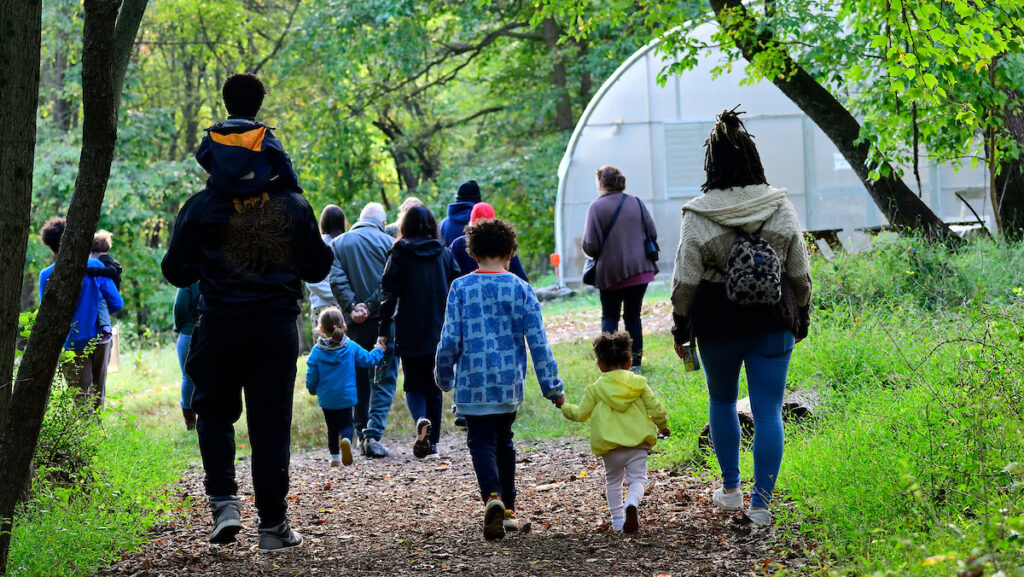
Photo: Bastiaan Slabbers September 24 – – December 30, 2022
The group exhibition Forest Makings features artwork by Jean Shin, Ana Vizcarra Rankin, Aaron Terry, Amir Campbell, Tali Weinberg, Vivien Wise, and instrument makers Gladys Harlow, Richard Robinson, and Don Miller (as part of the art project S(tree)twork by Futurefarmers). While shedding light on the environmental benefits of forests and the threats posed by changing climates, Forest Makings explores how humans influence forests and manage their survival through practices of conservation.
Companions
April 16 – August 13, 2022
The multimedia exhibition Companions by Filipino-American visual artist Maria Dumlao in collaboration with Filipinx group Bahay215, Nicky Uy and Omar Buenaventura, explores food culture as a vehicle for the human desire for belonging and rooting into a new environment. The exhibition features a series of interactive prints and site-specific installations that open a dialogue about ecology, authorship, and cultural authenticity in today’s intertwined environments.
Aqua Marooned! (An Interactive Card Game)
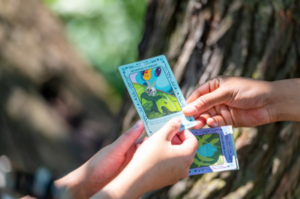
November, 2021 – Summer, 2022
We have launched a unique and delightful card game the whole family can play on site. Stroll along our trails while quizzing each other on local plants and animals, composing poems about spaces you encounter, honoring the Lenape peoples who have traditionally stewarded the land—all the while deepening your connection to the natural world around you. Pick up a free deck of cards at our Visitor Center. This is a collaboration with the performing arts collective Swim Pony.
Al-Mudhif – A Confluence
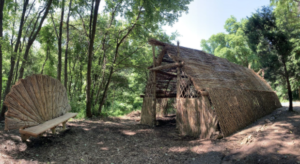
June 25 – Summer 2022
Al-Mudhif – A Confluence was an outdoor art installation by Sarah Kavage and Yaroub Al-Obaidi and an accompanying exhibition that explored notions of belonging and healing amidst the current moment of careful reconnection. Entirely built out of the invasive wetland grass phragmites, the installation and gallery display provided a welcoming space for intercultural encounters here while offering a critical perspective on global migration of plants and people.
LESS IS MORE: The Nature of Letting Go
Dec 2021 – 26 Mar 2022
The Schuylkill Center presents the solo exhibition “LESS IS MORE: The Nature of Letting Go” by Philadelphia-based visual artist and community organizer Makeba Rainey. Her artwork blends layers of imagery of ancestors, Black Liberation leaders, and local figures from the African-American community. By harvesting from the environmental initiatives and voices in Philadelphia and creating sacred, meditative, and self-reflective spaces in the gallery and outdoors, Rainey’s artwork will shed light on the practices, emotions, and resiliencies that sustain Black communities in our metropolis.
Throughout this winter, the gallery at the Schuylkill Center is decked out in dazzling portraits of local Black figures, Liberation leaders, and ancestors, created by local artist Makeba Rainey. Bright colors and patterns of African wax cloth frame defiant, determined, and joyful faces—all layered on handmade, wildflower-seeded paper that can be planted after the show. Beyond her signature-style portraits, Rainey transforms the gallery into a healing, meditative space complete with a cozy reading corner for rest and reflection.
With the exhibition, titled “LESS IS MORE: The Nature of Letting Go,” Rainey explores how Black folks can access the energy of nature necessary for community and self-sustainability. More particularly, Rainey asks us, how do we harness nature while also living in ethical and resourceful accord with it? Especially in this time of global scarcity—scarcity more keenly and unjustly felt by those living in already under-resourced communities in our city—what does it look like to live sustainably, to find sustenance in ancestors, neighbors, family, and friends?
In that vein, Rainey’s work is characterized by close and extended collaborations with fellow artists, local organizations, and community members. Indeed, “artist” is only one of many titles Rainey would give herself; others include curator and community organizer. Her creative practice “focuses on building community,” which she considers “an extension of family,” and key to her social justice work, in which “community becomes the key to liberation,” particularly Black Americans. Makeba Rainey’s exhibition at the Center is a presentation of understanding environmental practice as a social event that grows on building ecological empathy across communities.
For this exhibition, collaborators will include fellow Philadelphia artists Dominique London (creator of Skoolie, a school bus turned sustainable tiny home), Sudan Green (of SpiritsUp!) and sound designer Julien Terrell, among others. With these collaborators, Rainey will offer self-guided, meditative walks, healing rituals, and art workshops.
UNLOCK: Tree Water Land
July 26 – Aug 6, 2021
Organized by Tina Plokarz
The performance project UNLOCK:Tree Water Land builds on the urgent contemporary movements of Black Lives Matter and WATER is LIFE. It includes dance, ephemeral interactive installations, live music, and guided embodied experiences for audiences to witness and join in. The residency is part of the collective’s multi-year effort to creatively decolonize natural spaces through visual art and dance; and ultimately their attempt to dismantle the systemic oppression of contemporary ‘isms.
Rob Carter: Cultured Lands
Apr 15 – June 5, 2021
In partnership with the West Collection, we are thrilled to present environmental artist Rob Carter’s inventive creations that encourage a dialogue among America’s history of colonization, land exploitation and controlled cultivation of plants. This multimedia installation explores the sustainable future of our land while contextualizing it specific to Philadelphia’s history of colonization and industrial urbanization. As Rob Carter’s work equally brings together art, ecology and history, the exhibition explores humanity’s relationship with the natural and built environments and challenges us to envision a future of our lands in which humanity and nature can sustainably coexist.
Works featured include the paper-based stop-motion animation u003ciu003eMetropolisu003c/iu003e (2008). The sped-up animation is an abridged narrative history of the city of Charlotte (NC), spanning the time period from 1755 on a Native American trading path through farming and the discovery of gold to today’s modern city. u003ciu003eMetropolis u003c/iu003eis entirely made from images printed on paper, representing the past, present, and future of landscapes and architecture while questioning the fragile excessiveness of humanity’s urban development dreams.
Side-by-side with historic cartographic material outlining farming lots in Philadelphia during William Penn’s late 17. century, the exhibition also features Carter’s recent project, Plant Writing (2020). With ink drawings and a time-lapse video, Carter documents the growth and movement of organic and genetically modified soybean plants over the course of several days. He captures both the action of the artist/scientist and the motion of the plants. This creative experiment inquires about our relationship to this highly processed crop – the most valuable US agricultural export.rnrnu003ciu003eCultured Landsu003c/iu003e is an invitation for dialogue about the rise of urbanization in our human-made area of the Anthropocene, especially in perspective of today’s American East Coast cities.
Citizen’s Eye
January 21 to March 21, 2021
The Schuylkill Center presents Citizen’s Eye — A Kaleidoscope of Nature, a communal photo album of nature encounters featuring over 400 images taken during the last 9 months of the COVID-19 pandemic. Asking how has nature been a part of your life in the midst of the coronavirus pandemic, the Schuylkill Center invited its community to share their favorite photographs of surprising encounters with nature and to become part of a kaleidoscopic display in its art gallery.
Nature can take us by surprise. An encounter that is often mutual and equally surprising to humans and other species. Our romantic idea of nature is usually characterized by spectacular landscapes, rushing rivers and lush forests, but in fact the little miracles of nature present themselves every day. In times when we’re spending our lives physically apart, we’ve started to discover the world around us through new eyes. With curiosity and appreciation, we started to deeply recognize the natural landscapes around us—how the sun is breaking through trees in front of homes, animals are populating the city streets, humans are navigating crowded trails, and tiny wildflowers are blooming on sidewalks. Whether in urban cityscapes, rural hideaways or private homes, for many of us nature has become a refuge, even a sanctuary, that allows us to breathe and recharge.
Asking how has nature been a part of your life in the midst of the coronavirus pandemic, the Schuylkill Center invited its community to share their favorite photographs of surprising encounters with nature. Citizen’s Eye is a non-juried exhibition that invites the greater community in Philadelphia and beyond to share their perspective on the natural world in these uncertain and changing times. The exhibition looks through the curious and compassionate eyes of Philadelphians and beyond, unfolding a new sense of discovery and recognition of nature’s systems and processes. Citizen’s Eyeu003c/iu003e is a nonlinear picture atlas that reconsiders humanity’s emotional connections to nature while putting the ephemeral nature of life into current perspective.
This exhibition is kindly supported by the Dolfinger-McMahon Foundation. The Schuylkill Center’s environmental art program is supported by the Pennsylvania Council on the Arts and the Philadelphia COVID-19 Arts Aid Fund.
Ecotactical: Earth Day at 50
Do we still need Earth Day as it was conceived in 1970? What do we need from it now?
When the first Earth Day was celebrated on April 22, 1970, the Environmental Protection Agency did not yet exist, nor did much of what we now know as the tapestry of environmental laws in the United States. Often credited with launching the modern environmental movement, the first Earth Day took place in a political climate thick with protests against the Vietnam War and the major American civil rights movement.
According to the Earth Day Network organization, Earth Day is now the largest secular observance in the world and is celebrated by more than a billion people each year. Over the years, commemorations of Earth Day have included political demonstrations along with celebrations of the natural world, tree plantings, and other encouragements of individual actions in support of environmental health.
As we look toward the 50th anniversary of Earth Day in April 2020, it feels like a very different time. Yet, the turmoil of our own moment and the increasing urgency of the climate crisis give the historical roots of the first Earth Day new relevance. Artists have played an important role in Earth Day from the beginning, regularly contributing graphic posters and iconography to buoy the movement, participating in Earth Day exhibitions, and offering dramatic, performative actions. Recognizing this rich legacy, the Schuylkill Center will host a gallery exhibition of works that respond to the question of what Earth Day means (or should mean) fifty years after it was first celebrated.
Support for this exhibition has been provided by the Joseph Robert Foundation
The Tempestry Project: Philadelphia Collection
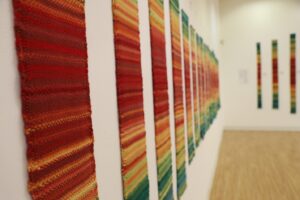
December 12, 2019 – January 11, 2020
The Tempestry Project is a global climate data visualization project through fiber arts, including knitting, crochet, and cross-stitching. A Tempestry is a wall hanging, or temperature tapestry, that represents the daily high temperature for a given year and location, with January at the bottom and December at the top – think of it like a bar graph. All Tempestries use the same yarn colors and temperature ranges, creating an immediately recognizable and globally comparable mosaic of shifting temperatures over time.
The Tempestry Project was founded by Justin Connelly, Marissa Connelly, and Emily McNeil in Anacortes, WA. During 2019, the Schuylkill Center coordinated a collection of Tempestries that showed Philadelphia’s daily high temperatures from 1875 to 2018, created by 30 volunteer knitters and crocheters. The collection was on long-term display at the Schuylkill Center to educate about how climate change is impacting our region.
We created an additional 7-piece collection which is available for loan to organizations in Philadelphia and the region for events, festivals, exhibitions, or temporary display. Please contact us if you wish to borrow the 7-piece Philadelphia Tempestry collection.
LandLab: Jan Mun
2017-2018 Resident Artist: Jan Mun
Jan Mun is a media artist that creates social sculptures working with digital and living media. The landscape has become her framework to unfold stories about others and herself by using a combination of artistic and scientific processes that manifest in the form of interactive installations, photography, performance, and bio-art. Jan creates interfaces to elicit participation as a reflection and critique of our political and social systems.
Working with communities such as Newtown Creek Alliance, BeeVillageNYC, NYC Mycological Society, and the Soil u0026amp; Microbiology labs at Brooklyn College Jan innovates ideas to be realized through research, chance, and collaboration. As a LandLab artist, she explored mycoremediation and shared her passion for mushrooms as “ecological instigators,” ultimately constructing The Mushroom Vortex Maze. The Mushroom Vortex Maze was constructed using wooden logs inoculated with three types of edible mushrooms to create separate rows that each forms a logarithmic/golden ratio spiral. By entering the maze to forage for mushrooms you could easily be dislocated at the center and exit from a different path than where you entered, changing your trajectory. Along the center of the spiral all three types of mushrooms were available, and, as is the case when this pattern is found in the natural phenomena, the center where you stood was also where the pattern was infinite.
The interaction within the Mushroom Vortex Maze was based on cultivation and our biological instincts for food; one is lured into the vortex maze to forge for food or simply out of curiosity. Foraging for mushrooms in the United States is discouraged due to risks of mistakenly eating poisonous species and the lack of knowledge to know the difference. This is one indicator of our dislocation to the natural environment toward a built environment. In the Mushroom Vortex Maze, a dialogue with these two relationships was created as another option to foster a symbiotic relationship the between natural and built environments.
Pvines
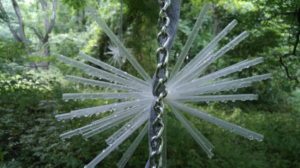
2017-2018 Landlab Resident Artist: Kate Farquha
During her residency, Kate conceived a collection of mythic micro-environments called Synestates. She thoughtfully inserted materials or elements from Philadelphia into the Schuylkill Center’s wild and cultivated lands, speculating about future possibilities for contact between people and the environment.
Support for LandLab is provided by the Knight Foundation, the National Endowment for the Arts, the Dolfinger-McMahon Foundation and the William Penn Foundation. This program is administered regionally by the Greater Philadelphia Cultural Alliance.
LandLab: Dance Exchange
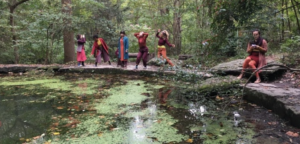
2017-2018 Resident Artist:Dance Exchange
During LandLab, artists from Dance Exchange explored Philadelphia’s waterways through movement exploration with visitors and local artists and scientists, culminating in installation and performance at the Schuylkill Center.
Civilization begins and ends at the river’s edge. Where land meets water, many human stories are told, histories are revealed and concealed, futures are envisioned, debated, and denied. The history and future of the Schuylkill River is one central to the story of our country and of southeastern Pennsylvania, and the implications of our relationship to the river are vital to our understanding of how we continue to care for our environment.
Through this residency, Cassie Meador (Executive Artistic Director of Dance Exchange) led a new project that explored the relationship between land and water. Meador collaborated with Jame McCray, an interdisciplinary ecologist, and Zeke Leonard, an artist who mobilizes community-based sustainability efforts through interactive musical objects and installations. The creative team used interdisciplinary dancemaking to move community members from a place of observation to participation to active stewardship.
Rain Yard
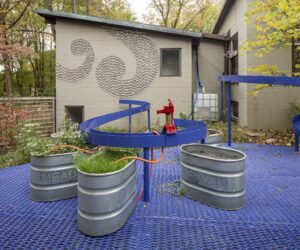
Stacy Levy’s Rain Yarduis an interactive artwork on permanent display in the Schuylkill Center’s Sensory Garden.
This innovative artwork serves a practical function in mitigating stormwater runoff from our building, as well as an interpretive function in highlighting the critical role that soil and plants play in the water cycle.rnrnn u003cemu003eRain Yardu003c/emu003e, we can see every part of the rain’s journey. But we don’t have to just look: we can also play with the pump and hoses to see how water filters over a variety of surfaces. Pump the pump handle and collected rainwater goes from the cistern through a hose and into the lower spiral. Follow the red pipe from the cistern to the pump, and create your own rain.
The plants below the platform grow in a basin, or bowl, dug into the ground. The size of the basin was calculated to hold the water that comes off the roof in a typical heavy rain fall. The basin holds the rainwater long enough for the plants and ground to soak it up. Then, the openwork platform allows rain to filter down, plants to grow up, and people to hover in between. The plants in the garden were carefully selected. They are all native to the area, and include goldenrod, aster, cardinal flower, blue flag iris, and rushes, grasses and ferns.rnrnThis artwork was created through interdisciplinary collaboration with ecologists, engineers, designers, educators and horticulturists.rnu003ch5u003e
Stacy Levy writes, “My work is about making metaphors for people to understand how nature works. I always hope my pieces will give someone a new avenue to understand something about nature. I think that everyone deserves a re-explanation of the everyday workings of the world. In some of my work, art can be an important new way to fix things that are not working well on a site. Rain Yard is trying to fix a rainwater issue in an artful way. An engineer might fix a rainwater problem one way, and a landscape gardener would do it another way. I have tried to take all of those perspectives and to solve the problem while making an intriguing spatial and visual experience out of the solution.”
About the Artist: Stacy Levy is an artist who works with natural processes of the surrounding nature. She received a BA at Yale (1984) where she majored in sculpture with a minor in forestry. This combination of art and nature has remained entwined throughout her path as an artist. Stacy co-founded Sere Ltd., a design firm specializing in native landscape restoration for municipal, corporate and private landscapes across the mid-Atlantic region. The firm works to bring the architecture of a healthy ecosystem back to disturbed forest landscapes. In 1988, Levy attended Skowhegan School of Painting and Sculpture and earned an MFA from Tyler School of Art, Temple University (1991) while working as a forester. The combination of forestry and
Rain yard was made possible by generous support from Arcelor Mittal, Johnson u0026amp; Johnson, Penn Engineering, Sherwin Williams and the National Endowment for the Arts.
Future Non-Object #1: Sol’s Reprise
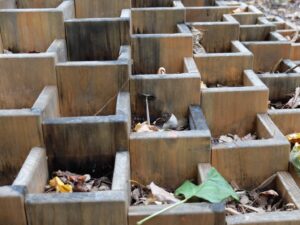
Landlab Resident Artist: Jake Beckman
During his residency, Jake Beckman explored the detritus and soil formation cycle of a forest and its disruption by invasive earthworms then created a sculptural installation that makes these hidden processes visible to visitors. “Future Non-Object #1: Sol’s Reprise” is inoculated with local fungal spores, which will break down the sculpture over time and enrich soil health.
Rot and decay are such an important part of the healthy life cycle of a forest, and yet for various reasons they are hardly ever celebrated. Where do the raw materials of life come from? What happens to “waste” in the forest ecosystem? How can the components of soil affect the health of an ecosystem?
About his exhibition, Beckman says, “As part of my residency exploring the ways in which dead organic matter is broken down and reincorporated into living organisms (a cycle called the detritus cycle), I looked closely at the essential role that fungus plays in the forest ecosystem. For instance, dead wood would remain utterly indigestible to the vast majority of forest organisms without fungi to break down the complex molecules of cellulose, hemi-cellulose and lignin. Rotting wood and its associated fungus can be seen throughout the grounds of the Schuylkill Center. Interestingly however, the fungal biodiversity in the part of the forest where my project is installed has been disturbed by, among other things, the presence of invasive earthworms and their voracious appetites for organic matter. Is there potential for remediation? By collecting fungal species from other healthier parts of the forest, introducing them into the sculpture, and collecting data over time, I’m curious to see if some measurable degree of biodiversity can be restored to this part of the forest.
As research progressed, I began to also look at the way in which inorganic material such as rock becomes integrated into soil through a slow process of fragmentation and dissolution via chemical, biochemical and mechanical means. I became fascinated by the layering of timescales that co-exist in soil, from the geologic scale of eons and millennia to the more organic scale of centuries, decades, years and months. On one level, my project is simply an outgrowth of the wonder I felt when learning about the complexities of soil. When I began my research, I was quickly reminded that nothing in the forest is “wasted.” Bacteria, fungus, plants, animals and all other manner of organisms work to glean nutrients from what is cast off or left behind when another life comes to an end.
I wanted to create an object that contained the seeds of its own undoing (an intention that runs counter to more typical considerations of a material’s archival qualities). As such, throughout the summer and fall, the wooden pile structure I have created will be inoculated with various species of fungus that I find on the grounds of the Schuylkill Center. Over time the sculpture will give rise to successive fungal blooms, slowly being consumed and reabsorbed back into the environment.”
About the Artist Jake Beckman: “I am a sculptor and educator living and working in Philadelphia. I was born in Cleveland, Ohio, and grew up minutes up the hill from the city line in Cleveland Heights. I teach Art and Design at the Community College of Philadelphia and graduated with an M.F.A. in Sculpture from the Rhode Island School of Design and a B.A. in Art from Swarthmore College. In addition to making work that explores systems and materials that sustain our way of life through a wide range of media, I have had a lifelong interest in biology, chemistry, and many of the other physical sciences.”
Support for LandLab is provided by the Knight Foundation, the National Endowment for the Arts, the Dolfinger-McMahon Foundation and the William Penn Foundation. This project was supported in part by the Pennsylvania Partners in the Arts program of the Pennsylvania Council on the Arts, a state agency funded by the Commonwealth of Pennsylvania and the National Endowment for the Arts, a federal agency. Support also provided by PECO. This program is administered regionally by the Greater Philadelphia Cultural Alliance.
LandLab: Native Pollinator Garden
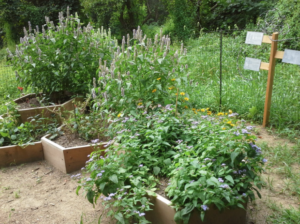
Maggie Mills, B.H. Mills
LandLab is an environmental art residency program that integrates art, ecological restoration, and public engagement, and is a joint project of the Schuylkill Center and the Center for Emerging Visual Artists (CFEVA).
Support for LandLab is provided by the Knight Foundation, the National Endowment for the Arts, the Dolfinger-McMahon Foundation and the William Penn Foundation. This project was supported in part by the Pennsylvania Partners in the Arts program of the Pennsylvania Council on the Arts, a state agency funded by the Commonwealth of Pennsylvania and the National Endowment for the Arts, a federal agency. Support also provided by PECO. This program is administered regionally by the Greater Philadelphia Cultural Alliance.
Marguerita Hagan, B.H. Mills, and Maggie Mills built “Native Pollinator Garden,” a pollinator-focused series of raised beds accompanied by a sculptural installation to educate about native plants, chemical-free gardening, sustainable practices, and the relationship between humans and bees. Hundreds of people assisted with making over 1000 ceramic bees, while hand-painted zinc-etched botanical signs identify the seven plant species growing in the hexagonal planting beds.
Welcome Home
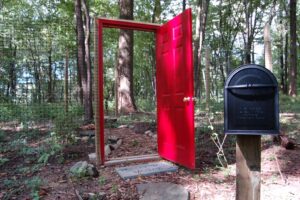
Welcome Home by Seattle-based artist Vaughn Bell, is an ongoing environmental art project designed to deepen visitors’ understanding of how the Schuylkill Center’s forest functions. The installation provides a “home” for plants that are native to Pennsylvania’s early forests, to dramatically illustrate the impact of invasive plants on the forest ecosystem.
Bell and a team of Schuylkill Center staff and volunteers, cleared the area inside the home of all invasive plant species, prepared the ground, re-planted with native plants, and created an enclosure to protect them while they grow. Over time, this project will show us the difference between a native forest and one filled with invasive plants species.
Welcome home includes black cherry, eastern redbud, spicebush, planted in an enclosed garden that allows visitors to enter, take a seat and enjoy the forest in a new way. The plants within this house are all species native to the area, evolving here for centuries, providing food and habitat for countless bird and animal species.
Human activities like logging, farming, and urbanization have transformed this landscape over time. We have introduced new species that have become invasive, crowding out natives while diminishing the forest’s diversity. Deer overbrowse young seedlings, not allowing the forest to regenerate. Even the climate is changing.
Now, the plants that live in this house require our care and protection to keep them safe while they become established. Visitors are welcome to come in and meet the native plants inside. Over time, you can see how the garden grows!
Assemblage: 20 Years of Environmental Art at the Schuylkill Center
January 30 – March 21, 202
Bill Botzow, Lorenzo Buffa, Carolyn Hesse, Maddie Hewitt, Brooke Hine, Jennifer Hynes, Jane Ingram Allen, Ellie Irons, Darla Jackson, Sarah Kaizar, Stacy Levy, Melissa Maddonni Haims, Mary Mattingly, Gina Michaels, Gary Miller, Maggie Mills, Jan Mun, Katie Murken (pictured), Rashida Ng, Kaitlin Pomerantz, Jennie Thwing,
“The biggest thing I’ve learned from nature is the importance of relationships. An ecosystem isn’t just a list of living things (squirrel, tree, bee, flower); it’s the set of relationships *between* those living things (the squirrel lives *in* the tree, the bee *pollinates* the flower). In terms of organizing, this means that a given social movement isn’t a list of organizations, or campaigns, or even individuals; it’s the set of relationships *between* organizations, campaigns, individuals…” – Farhad Ebrahimi, from Emergent Strategy, by adrienne maree brown
Founded in 2000 as an opportunity for artists and audiences to explore and interpret the natural world and current ecological issues, our environmental art program has brought hundreds of artists to the Schuylkill Center to present contemporary art work in the gallery and on our trails. 2020 is the 20th anniversary of the art program, and this exhibition acknowledged and celebrated the links of the past, present, and future of environmental art in this land, and beyond.
Assemblage: 20 Years of Environmental Art at the Schuylkill Center celebrated the art program’s history by inviting selected previously exhibiting artists to revisit the work they did at the Schuylkill Center, and looked to the future of environmental art with new artists exploring related themes. Partially a retrospective, Assemblage displayed artifacts, records, sketches, and more from the Schuylkill Center archives to reveal aspects of the art program’s history and growth. We also invited select past artists to show newer works that related to their projects at the Schuylkill Center, charting the evolution in their own practices connected to the environment.
The epigraph above was written in the context of organizing for social change, but we can easily apply it to environmental art. The list is long of exhibitions and artists and projects and staff and collaborating organizations that have been involved at the Schuylkill Center since the art program was founded here in 2000, but the connections *between* these individuals, artworks, projects, organizations, and the Schuylkill Center’s land is what has made the program possible.
“Assemblage” is a term with uses in the fields of both art and ecology. In art, it refers to three-dimensional works of art made by intentionally grouping found or otherwise unrelated objects. In ecology, an assemblage of species is a group of organisms that co-occur in the same space and interact through various relationships. In assembling the items currently in this gallery, we sought to reflect the richness of the assemblage of artists and artworks in the Schuylkill Center’s environmental art program, and what it may generate that we can’t yet foresee.
Support for this exhibition has been provided by the Joseph Robert Foundation
Environmental Art Program History
In 1999, the Schuylkill Center had just completed its first 10-year master plan, with the recommendation that the Center diversify its programming to bring in new audiences. With that goal in mind, renowned curator Mary Salvante approached the director at the time and proposed an art program as a strategy for attracting new visitors, rightly recognizing the rich potential of the Schuylkill Center site as inspiration for artists, and art as a pathway to support the organization’s mission. The program began at a small scale with exhibitions in the Visitor Center gallery (which at the time consisted of two walls in the lobby, where the gift shop is now), while putting together grant applications for funding of larger initiatives such as an artists-in-residence program and outdoor temporary art exhibitions.
Over time, the environmental art program has grown to be one of the Schuylkill Center’s four core program areas, and one of the most unique and ambitious art programs based at a nature center nationally. The goals of the program have expanded to align not only with the Schuylkill Center’s educational goals, but its land stewardship goals. Recognizing the potential of art to actually help solve ecological challenges, the program started focusing more on active projects in the landscape, such as launching our LandLab residency, which tasks artists with collaborating with scientists and our staff to create installations that benefit the land, or prevent or remediate environmental damage. In 2012, we built a larger, more defined gallery space to allow for more ambitious indoor exhibitions. All told, over 350 artists that have participated in over 70 exhibitions and projects since the program’s inception.
Buprestid Insulae
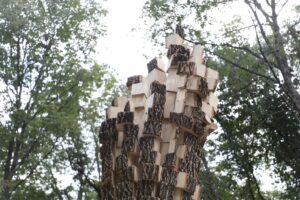
As part of The Schuylkill Center’s 2019 exhibition We All Fall Down: Artists Respond to the Emerald Ash Borer, Anthony Heinz May created a site-based sculpture from a standing dead ash tree, calling attention to the relationships between humans, nature, and technology. Today, Buprestid Insulae can be found near the Fire Pond at the Schuylkill Center.
We All Fall Down: Artists Respond to the Emerald Ash Borer A STEAM project sponsored in part by the Philadelphia Science Festival
Since the emerald ash borer arrived in the midwest United States in 2002, it has rapidly decimated many forests, resulting in the death of millions of ash trees. With a 99% kill rate, it will sweep through our area like a wave and wipe out all of Philadelphia’s ash trees in the next 5-10 years. The emerald ash borer and its distinctive D-shaped bore hole was first seen at the Schuylkill Center in Summer 2018, and with some areas of the Schuylkill Center property having as much as 50% of its canopy composed of ash trees, the ash borer will have a significant impact on our ecosystem.
Aglow: Aurora Robson
This exhibition presented the suspended and illuminated plastic works of renowned environmental artist Aurora Robson. A multimedia artist known primarily for her work intercepting the waste stream, Robson transforms plastic debris into mesmerizing, bold sculptures that disguise and transcend their material. While drawing attention to the global challenge of single-use waste, Robson values plastic as an art material for its durability and pliability. Robson seeks to imbue these often overlooked materials with care and intention, encouraging a viewer to consider their own relationship with waste and the waterways where it so often is discarded.
This exhibition was supported by the Joseph Robert Foundation.
Community 2019
February – April 2019
The Schuylkill Center’s Environmental Art program is proud to have presented Community, a gallery show celebrating the art works of the Schuylkill Center’s community. Community was a non-juried, salon-style exhibition that celebrated the creativity of our members, neighbors, staff, volunteers, and friends. Featuring 92 artists of any age, medium, style theme, or concept, this show was a portrait of a vibrant, diverse, and multifaceted ecosystem of makers.
Braided Channel
We are thrilled to have presented the 2018 Henry Meigs Environmental Leadership Award, our highest honor, to renowned environmental artist and sculptor Stacy Levy. Linking art with science, Levy harnesses ephemeral changes in nature with the lasting presence of sculpture. Rather than simply showing how nature works, Levy has also created and built many projects that solve environmental issues on the site. Levy was the first artist to receive the Meigs Award.
Levy is a distinguished sculptor whose work has broken new ground in linking the worlds of art and science. She uses the language of landscape and art to tell the ecological story of site, and her projects reveal the sometimes hidden natural world in the urban environment. Stacy works closely with landscape architects, engineers, horticulturalists, hydrologists and biologists to create artworks that allow natural systems, like the infiltration of rainwater, to function and thrive. From rivers to runoff, Levy has explored many facets of water along with other ecological subjects.
Through a lyrical approach to natural science, Levy blends an understanding of sustainable design and ecological concepts and harnesses the ephemeral changes of weather and seasons with the lasting presence of sculpture. Rather than simply showing how nature works, Levy has also created and built many projects that solve environmental issues on the site. In addition to her site-based work, Levy has shown extensively at museums and galleries. A native of Philadelphia, she has developed work across the country and internationally.
The Schuylkill Center’s art program has worked with Levy a number of times; most recently, Levy created Rain Yard, an innovative outdoor artwork which manages the stormwater runoff from our Visitor Center’s roof.
Braided Channel celebrated Levy’s career to date and presented a new extension of her community-based water work. The gallery featured moving image documentation of a sampling of Levy’s site-based works. Documentation is often a challenge for these works, which are ever-changing in response to environmental conditions, and activated in new ways over time by the presence and participation of people and nature. How alive these works are is often difficult to capture in a gallery setting, with still images serving as a very limited translation of the experience of a site. For this exhibition, Levy developed short, gestural videos that offer dynamic views of these site-based works brought indoors. They offered windows into the places where a selection of Levy’s works are living out into the world.
In the Schuylkill Center gallery, Levy had developed a new iteration of a body of work that engaged community members in gathering water samples along the full length of local waterways. The visual display of these samples invited reflection on what is seen and unseen in water quality. For the Schuylkill Center, Levy instigated a gathering of water along the length of the two streams on the our grounds (Smith Run and Meigs Run), displayed in a library of local water specimens. Starting from the headwaters near Hagy’s Mill road and ending near the Schuylkill River Trail, teams of staff and volunteers walked along the stream channels grabbing a sample every 80 feet. This cabinet of water provided one way of looking at a small watershed comprehensively. Notably, Smith Run and Meigs run are named for two of the founding families of the Schuylkill Center, which include the namesake of the Meigs award.
For her exceptional work in art; the elegance with which her work reveals ecological processes that otherwise may go unnoticed; her pioneering approach to working not just in, but with nature; and her spirit of collaboration and uncanny ability to galvanize community members and specialists across disciplines; celebrating Levy with the Meigs award and a gallery of her work was a fitting way to conclude the Schuylkill Center’s 2018 Year of Water.
Levy graduated from Yale University in 1984 with a BA in sculpture and forestry. She received her MFA in 1991 from the Tyler School of Art. She spent a year at the Architectural Association in London, England. In 1992 she was awarded a Pew Fellowship, and has been a recipient of a Pennsylvania Council on the Arts Fellowship and a Mid-Atlantic Foundation grant.
Art in the Open
September 13 – October 27 2018
Our fall 2018 gallery show featured artworks created as part of Art in the Open, a public art program in which selected artists created their work on the Schuylkill Banks for three days in May. Ten artists working in a range of media presented work in our gallery and on our trails.
About Art in the Open: Art in the Open is a biennial citywide event that celebrates artists, their inspirations for creating art, and their relationships with the urban environment. In 2018, 30 artists were selected by jury to utilize the Schuylkill River Banks as their studios, making their creative process accessible to everyone. Working over the course of three days (May 13–15, 2016), these artists infused the River Trail—from the historic Fairmount Water Works to South Street—with art, inspiring new ways of seeing the river and Philadelphia.
Wet Lab
May 23 – August 18, 2018
Water is essential, both to our planet and to our programming. The Schuylkill Center named 2018 the Year of Water, and water flowed indeed through many of our programs over the course of the year. The art program focused our exhibitions on various angles on water topics, and, in the summer, we opened up our process for broader participation by area artists and the public.
Part of the Schuylkill Center’s mission statement charges us to serve as a living laboratory; our LandLab residency likewise serves as a generative program to support artists experimenting with ecological works of art on our site. In order to facilitate Wet Lab, our art gallery was transformed into a laboratory as well.
Throughout the summer, our art gallery became Wet Lab, a space for artists and Schuylkill Center visitors to explore and reflect on water in a dynamic environment. In contrast to a more traditionally curated exhibition, the artists, art works, and projects on view flowed and shifted throughout the summer. Artists displayed completed works along with works in progress, at times using the gallery as their studio to work through a new idea or test creative hypotheses. Sometimes multiple artists were in the space, at other times one artist occupied the whole space.
As our 2017-2018 LandLab artists approached the end of their residencies in the summer, Wet Lab allowed them space to make their process visible to audiences. Other local artists joined Wet Lab for shorter term engagements, exploring water from a variety of angles. Water-related books, readings, questions, and reflections provided visitors with resources to do their own observations and sink into their own water laboratory in the gallery space. And, Schuylkill Center staff reflected on water in various ways, gathering learnings and insights from our Year of Water programming to date.
Learn a River’s Name
January 25 – April 21, 2018
Names are the way we humans build relationship, not only with each other but with the living world.” -Robin Wall Kimmerer
What’s in a name? It’s one of the first things we ask someone when we meet them, yet often quickly forgotten. It’s often something given to us by others, yet expected to serve as a distillation of our identity. Who gets to decide a name is often a question layered with power dynamics, whether it be a people, places, organisms, ecosystems.
Yet, despite these complexities, in a 2017 New York Times op-ed, from which the title of this show is taken, Akiko Busch writes, “Giving something a name is the first step in taking care of it.” Thinking of bodies of water, a name is an opening, a prelude, a microcosm, a way to be known – a first step on the pathway to meaningful connections between people and nature.
This exhibition was guided by this question: how can art help us to know a river’s name, to not only value it but know it, and therefore to seek to steward it? With a focus on water bodies in the Mid-Atlantic region, seven artists explored the rivers and streams that are neighbors to the Schuylkill Center — the Schuylkill, Delaware, Brandywine, and Hudson Rivers.
Learn a River’s Name consisted of artworks and art investigations that provided inroads to getting to know our rivers. It included projects that incorporated deep and focused engagement with a particular river, watershed, or stream. Featured alongside final products were relics from artistic processes by which an artist got to know a river in ways that might feel a lot like how we might get to know a person. Learn a River’s Name also included art works that revealed something unseen about a water body’s characteristics, its essential nature.
Wendell Berry wrote, “People exploit what they have merely concluded to be of value, but they defend what they love, and to defend what we love we need a particularizing language, for we love what we particularly know.” Learn a River’s Name was an invitation for us to better know a river near us, a call to action to know not just its name, but its features, its needs, and how we can be a good neighbor to it.
Mare Liberum is a collective of visual artists, designers, and writers who formed around a shared engagement with New York’s waterways in 2007. As part of a mobile, interdisciplinary, and pedagogical practice, the collective has designed and built boats, published broadsides, essays, and books, invented water-related art and educational forums, and collaborated with diverse institutions in order to produce public talks, collaborative exhibitions, participatory works, and voyages. Mare Liberum has presented work at the Centre Pompidou – Musée national d’art moderne, Paris, the Carpenter Center for the Visual Arts at Harvard University, the Parrish Art Museum, MASS MoCA, the Neuberger Museum, and EFA Project Space, among others.
The collective is Jean Barberis, Dylan Gauthier, Ben Cohen, Stephan von Muehlen, Arthur Poisson, Sunita Prasad, and Kendra Sullivan.
Anthrobotanical
September – December 2017
Most people know that we rely on plants for the food we eat and the air we breathe, but the interconnections between plants and people actually go much deeper and are more nuanced. Scientists continue to discover the complexities of how plants take in and respond to information, even communicating with each other through underground networks and chemical signals. Human systems powerfully influence plant communities, locations, and health – and they also exert a powerful influence over us. Yet, despite the intricacies of the plant-human relationship, plants are often overlooked, even compared to other aspects of the natural world.
LandLab Project: #StormSnakes
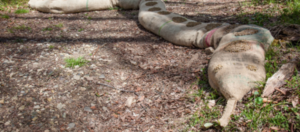
LandLab: Leslie Birch
#StormSnakes, by Leslie Birch, explored the issue of stormwater run-off using electronics to collect data from a Schuylkill Center stream. Partnering with Stroud Water Research Center, she created a cost-effective DIY sensor that collects data on the impact of stormwater on streams at SCEE. She also created burlap snake sculptures to stop and slow runoff and decrease erosion.
LandLab is an environmental art residency program that integrates art, ecological restoration, and public engagement, and is a joint project of the Schuylkill Center and the Center for Emerging Visual Artists.
Support for LandLab is provided by the Knight Foundation, the National Endowment for the Arts, the Dolfinger-McMahon Foundation and the William Penn Foundation. This project was supported in part by the Pennsylvania Partners in the Arts program of the Pennsylvania Council on the Arts, a state agency funded by the Commonwealth of Pennsylvania and the National Endowment for the Arts, a federal agency. Support also provided by PECO. This program is administered regionally by the Greater Philadelphia Cultural Alliance.
LandLab: WE THE WEEDS
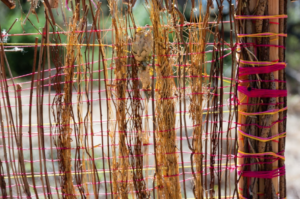
WE THE WEEDS: Kaitlin Pomerantz and Zya S. Levyu
LandLab-Program is an environmental art residency program that integrates art, ecological restoration, and public engagement, and is a joint project of the Schuylkill Center and the Center for Emerging Visual Artists (CFEVA). Support for LandLab is provided by the Knight Foundation, the National Endowment for the Arts, the Dolfinger-McMahon Foundation and the William Penn Foundation. This project was supported in part by the Pennsylvania Partners in the Arts program of the Pennsylvania Council on the Arts, a state agency funded by the Commonwealth of Pennsylvania and the National Endowment for the Arts, a federal agency. Support also provided by PECO. This program is administered regionally by the Greater Philadelphia Cultural Alliance.
WE THE WEEDS (a collaboration of artist Kaitlin Pomerantz and botanist Zya Levy) created a woven installation constructed from invasive vines, simultaneously encouraging dialog about the global movement of plants and removing hazardous invasive species from the forest. They harvested and wove with invasive vines on two large hand-built looms with Schuylkill Center visitors of all ages. The completed weavings were installed as one large work, called “Interwoven,” in a vine-dominated meadow , where the living vines consume their tapestried counterparts.
Artist Statement
For the LandLab Residency, we built a woven sculptural installation made from invasive vines that explores the interwoven histories of humans and plants, and their mutual global migrations. The work creates an opportunity for dialogue about the perception and management of invasive species, the impact of human disturbance of plant populations, and the harms, as well as benefits and uses, of invasive plants. Our process began with an investigation of flora on the Schuylkill Center property. Botanical surveys in the spring and early summer resulted in a list of common plants, including natives like the May apple and black cohosh, and non-natives like wineberry and oriental bittersweet. The plants we observed on the Schuylkill Center property act as a snapshot of history up until this point: the presence of many of the invasive species tells of habitat fragmentation, pollution, material desires, while the re-establishment of many native species speaks of a renewed interest in being responsible stewards of the land.
Making in Place
MAY – AUGUST 2017
Fourteen artists extended our art gallery onto the trails in the summer of 2017, with works that responded to their installation site, exploring concepts of placemaking, reused materials, and natural-unnatural sound. These works, both indoors and on the trails, were created as part of Art in the Open, a public art program in which selected artists create their work on the Schuylkill Banks for three days in May.
Visitors enjoyed artist talks, light refreshments in the gallery, a guided walk to the outdoor installations, and site-specific performance at the reception. An opening reception took place on May 24, 2017, and the exhibition was on view until August 12, 2017.
Community
January – March 2017
The Schuylkill Center’s Environmental Art program proudly presented , a gallery show celebrating the art work of Schuylkill Center members. Community is a non-juried, salon-style exhibition, open to Schuylkill Center members, neighbors, staff, and volunteers. Featuring artists of any medium, style, theme, or concept, this show created a portrait of our community, of a vibrant, diverse, and multifaceted community of makers.
Community revealed how people see nature in Philadelphia and inspired everyone to connect with nature in their own way. An opening reception took place on January 26, 2017, and the exhibition was on view in our gallery until March 25, 2017.
Going Up
September 24 – December 15, 2016
Going Up: Climate Change + Philadelphia
Eight artists take on life in a warming world
Daniel Crawford, Jim Frazer, Lorrie Fredette, Eve Mosher, Jill Pelto, Kaitlin Pomerantz and John Heron, and Michelle Wilson
Though unquestionably one of the most pressing issues of our time, climate change is classically difficult for us to wrap our minds around. Art about climate change has a unique potential to make these problems personal and relevant, with artists able to serve in the role of commentator, collaborator, storyteller, catalyst, and more. Drawing lines between global phenomena and what happens in our own lives and communities means the difference between despair and engagement.rnrnEight artists explored various dimensions of the future of a hotter, wetter Philadelphia. Two artists made “river prints” dipping handmade paper into the pollution on the surface of the Delaware River; one painted exquisite watercolor landscapes, the contours following the data graphs of key climate indicators such as CO2 concentrations; another artist created paper works inspired by the tunnels built by bark beetles.
Bryophilia
June 10, 2016 – August 13, 2016
Marion Wilson
In summer 2016, the Schuylkill Center hosted Bryophilia, a gallery show of artist Marion Wilson’s stunning digital photographs of microscopically enlarged moss species. Wilson prints intricate and lush photographs of tiny sprigs of moss on treated mylar sheets, hundreds of times the normal species size. From afar, these magnificently scaled up prints appear to be alien forms, and invite a closer look to interpret these curious shapes and structures. Layers of mylar prints lend depth and dimension to the images, echoing the layering of moss often encounted on a mossy rock.
Moss – part of the bryophyte phylum – captivates Wilson as the first form of plant life, yet often the most overlooked. Over 22,000 species of moss are known to exist in the world – a highly specialized and place-based species, they are found on every continent and are incredibly intricate and varied when viewed up close. From our human height, we often observe moss as a uniform green carpet over rocks and decaying logs – but in fact that “moss” is in fact many different mosses, tapestried together in wildly varying colors textures, and forms. Renowned bryologist Robin Wall Kimmerer, professor of environmental biology at the SUNY College of Environmental Science and Forestry and collaborator of Wilson’s, describes mosses as “coral reefs of the forest.”
The Foragers
January 28, 2016 – April 2, 2016
Melissa Maddonni Haims and Josh Haims
Both whimsical and delicate, these richly colored artworks give small windows into the vibrant forest floor. In fiber sculpture and photographs, The Foragers explored how nature can create something from almost nothing. Featuring all manner of fungi – brackets, buttons, ruffles, and the quintessential toadstool – Melissa Maddonni Haims’ and Josh Haims’ work celebrated the diversity and surprise of wild mushrooms in the forest ecosystem.
For Melissa, mushrooms have represented a journey in biomimicry, sparked by reading Janine Benyus’ seminal text on the subject. Inspired by the forms of these fungi, Melissa creates crochet mushrooms and assembles forest tableaus using bark and wood foraged in local forests. Fiber feels like a completely appropriate medium to explore the mycology of our local forests, analogous to the fibrous mycelium through which the fungus spread in the soil before fruiting into the diverse and beautiful mushroom forms.
Josh’s photographs bring these mushrooms to saturated, luminescent life. The images glow in warm hues, minute details from the forest floor illuminated and celebrated. The photographs capture a perfect stillness, moments of time frozen, and at the same time demonstrate living energy embodied.
This husband-wife team has long been mesmerized by mushrooms. Early in their relationship, Josh, who is from Manhattan, recommended that they go mushroom foraging in Fairmount Park when visiting Melissa in her native Philadelphia. Having never been mushroom foraging before, the two stumbled over rocks and downed wood in the forest near the Valley Green Inn in the Wissahickon. What seemed frivolous and foolish at first turned into twenty years of photographing local fungi and mycology enthusiasm.
Hackensack Dreaming
November 5, 2015 – December 19, 2015
Nancy Cohen’s Hackensack Dreaming transformed the Schuylkill Center’s gallery space into an immersive experience evoking the complex wetlands of the Hackensack River. Made of over 130 pieces of glass, handmade paper, and rubber, Hackensack Dreaming explores fragility, perseverance, and the new realities produced by the human and natural colliding in unexpected ways.
The work was the artist’s response to her time spent exploring the wetlands around New York City – a place where human and natural forces meet and give rise to something wholly new. Cohen explores what nature means in an urban context and in a changing global environment, using a quiet, nearly forgotten marsh as inspiration and reference point. Tucked between a Walmart, outlet malls, and a wastewater treatment plant, and within view of the New York City skyline, the wetlands of the Hackensack River spoke to Cohen as an “isolated puddle of the organic in a deluge of the human-made.” Yet, nature has adapted and carried on despite this disturbance, with plants and birds making unlikely homes and building a new future in this space full of contradictions.
Hackensack Dreaming came to the Schuylkill Center after premiering at New Jersey City University, and travelled to Duke University after a six-week run.
The Mountain and The Bumblebee
September 19– October 24, 2015
Organized by Chris McGinnis
Contributing Visual Artists and Poets:Rick Barot Patrick Bizzaro Robin Clarke Matthew Conboy Todd Davis Wesley Dunning Heather Green BA Harrington Chele Isaac Chris McGinnis Erika Osborne Josh Reiman Gwyneth Scally Meg ShevenockIn 1842 the geologist and land surveyor John C. Frémont led a prestigious expedition to explore the Rocky Mountain territory. In his travel log Frémont records an unlikely high‐altitude encounter with a bumblebee where he imagines each of them to be the first of their species ever to brave such geological extremes. This unlikely encounter is suggestive of America’s unique brand of landscape nationalism that has historically attempted to reconcile both expansionist and conservationist thought. Romantic descriptions of Frémont’s adventures were published in the Emigrant’s Guide to California and effectively united the interests of science and nature within the cultural framework of national inheritance. After all, “landscapes are culture before they are nature; constructs of the imagination projected onto wood and water and rock.”
The Mountain and the Bumblebee brought together selected works by contemporary artists and poets who confront broadly defined notions of landscape as both cultural icon and raw material. Working in a variety of media including photography, sculpture, painting, digital media, and poetic verse, featured artists maneuvered the complex web of references contributing to our understanding of landscape. Scenes from Hollywood westerns, survey photographs and miniature paintings highlighted America’s often contradictory role as both steward and exploiter of the land.
—Chris McGinnisOpen Spaces: Art in the Open
June 1st – July 25th, 2015
Featured artists: Nancy Agati, Harry Bower, Ellen Brooks, Josh Harris, Aaron Lish, C. Paiza Mannella, Sandy Sorlien, Susan Wilson, and Wendy Wolf.
From the Schuylkill Banks to the Schuylkill Center, nine artists from Art in the Open 2014 brought their creative process to our gallery and trails. Each uniquely suited to the Schuylkill Center context, they each explored one or more key elements in their work: ecological (the art work explores, reflects, or seeks to educate on environmental themes); meditative (the art work activates spaces in a way that encourages reflectiveness and mindfulness in the visitor, and encourages a moment of meditation and peace);and material (the art work’s materials are natural, recycled, repurposed, or arranged in a way that reflects an environmental ethic or perspective).
Five artists were on view in the gallery – themes of playfulness and flow exuded from the work, all reflective of different aspects of the Schuylkill River, its watershed, and its inhabitants. Three artists reframed their Art in the Open work outdoors on the Schuylkill Center trails, celebrating the diverse landscapes of Philadelphia as inspiration and open air studio, revealing new ways of seeing the world around us. Finally, Wendy Wolf created a satellite exhibition in the Schuylkill Center’s lobby and newly remodeled Widener Wing in mid-June, highlighting our building’s grand sloped wooden ceilings and floor to ceiling windows with a hanging installation of oversized leaves fabricated from plastic, a decidedly human material.
Each installation in this show created a new space to reflect on our relationship with the world around us, and opened up insights on the artistic process. The artists explored and celebrated the natural beauty and urban character of Philadelphia, and the complex and fascinating interactions between nature and the city.
Inhabiting the Edge
January 28– April 11, 2015
Narrating a watery ecotopia, the interior contained a living space, work space, public, and performance space that combines art, architecture, and ecology. WetLand’s ecosystem contained rainwater collection and purification, greywater filtration, dry compost systems, outdoor vegetable gardens, wetlands, and hydroponic gardens. Residents lived onboard and host activities, including free workshops, performances, and events.
Art is integral to imagining new worlds. Launched on August 15, 2014 on the Delaware River, WetLand was a mobile, sculptural habitat and public space constructed to explore resource interdependency and climate change in urban centers. A floating sculpture, it resembles a partially submerged building, integrating natural living systems with our urban space.
The goal of WetLand was to encourage individual community members to apply the ideas brought to life on board. Equal parts symbol, social space, stage, and shelter, the WetLand sculpture was an argument for thriving local environmental economies.
This gallery show contained concept drawings and preconstruction sketches, photographs and documentation of WetLand from August-September 2014, and artworks created by artists who were in residence aboard WetLand.
Contributing Artists:
Mary Mattingly
Rebecca Aston
Mollie Goldstrom
Saito Group
Brian House
Greg Lindquist
Jane Long
ANI New Media
Tom Newman
Heidi Ratanavanich
Kim Reid
David B. Smith
Meg Stein
Karla Stingerstein
Jacques-Jean TiziouFrost
February 15, 2014 – April 18, 2014
Nancy Agati and Amie Potsic, Frost
Opening Reception – March 1, 2014, 4pm
Two artists explore winter through installation, mixed media, and photographic work.In winter, patterns emerge from the harsh relief of cold temperatures and heavy snow that illuminate the relationship between us and the changing environment in which we live. This cold is at the heart of Frost, in which two Philadelphia artists took on winter as their subject. Amie Potsic and Nancy Agati delved into the meaning of winter through a mixture of photography and mixed media.
Agati and Potsic draw elements of nature into their work, giving voice to the natural world and putting it in dialogue with both the viewers and the artists themselves. Potsic’s photographs and installations focus on the intersection of the socio-political and natural worlds, challenging the viewer to question stereotypes, cultural norms, and politics. Endangered Seasons highlights the change of seasons as indicators of ecological wellbeing, while the Made in China winter series utilizes seductive beauty to encourage grappling with difficult issues. Agati’s sculptural installations use natural materials to create forms which resonate with the patterns, shapes, and complex structures of the natural world. She investigates growth patterns in nature by playfully rearranging collected reeds, branches, and seed pods into forms reminiscent of winter’s decorative ornamentation.
Whether it was Agati’s striking sculptures, Potsic’s photography, or their interaction that transports you, Frost created a world that was both uniquely its own and deeply connected to its inspiration: our natural world.
For more of Agati and Potsic’s work, please visit their websites: http://www.nancyagati.com/ and http://amiepotsic.com/
In Danger
October 1, 2013 – January 4, 2014
Opening Reception – October 12, 4 – 6 pm.The Schuylkill Center presented a series of drawings based upon the 1,115 species identified on the U.S. endangered species list.
Kaizar wanted to “compose a showcase for these imperiled creatures, capturing their wide range of forms, patterns, textures and personalities.” This exhibition presented an engrossing and alarming number of animals in danger of extinction, in their intricate and beautiful detail. While it is a chilling reality, we believe recognizing and celebrating these vulnerable life forms is an essential part of increasing public environmental awareness.
The Schuylkill Center works tirelessly to ensure a protected haven for hundreds of species, as well as operates a full time Wildlife Clinic for injured animals in the Philadelphia region. While this exhibition does not limit itself to only local species, we are keenly aware of the danger our local wildlife face daily.
To ensure accuracy, these drawings are periodically reviewed by an extremely helpful and generous group of biologists: Dr. Benjamin Keck, a post-doctoral associate at the University of Tennessee at Knoxville; Kristen Kuhn, a research affiliate at the U.S. Dept. of Agriculture; Dr. Thomas Near, associate professor at Yale University and curator of the Yale University Peabody Museum of Natural History; and Greg Watkins–Colwell, collections manager of Herpetology & Ichthyology at the Yale University Peabody Museum of Natural History. Working from photographs Kaizar creates these pen and ink drawings while riding the train to and from work.
For more of Kaizar’s work, please visit http://www.sarahkaizar.com/
Second Home
March 24 – May 4, 2013
Maggie Mills brought her distinct eye for children and the spaces they inhabit here in the spring of 2013. She observed SCEE’s after school program, the Monkey Tail Gang, and created this series of evocative portraits of the nature center’s unique spaces and the kids who enjoy them daily. Juxtaposing simplified, graphic landscapes with realistic figures, Mills’ large oil paintings explored the children’s special relationship to their second home.
Mills is a current fellow with the Center for Emerging Visual Artists Career Development Program (CEVA) and has exhibited widely in Philadelphia and elsewhere. She received her BFA from Tyler School of Art and her MFA from the Pennsylvania Academy of Fine Arts.
Our Monkey Tail Gang After School program is guided by our belief that unstructured free play in nature, can be as important to a child’s growth and development as time spent in the classroom. Monkey Tail Gang children learn from and are enriched by the natural beauty of our 340 acres of woods, streams, ponds and meadows.
Artist statement
The natural world has become a secondary home for most of us, with the developed world structuring our lives. The decomposition of nature and industry and the perceived fragmentation of time and space due to technology define our environment. The young navigate these inherited spaces often with little guidance.
The Schuylkill Center acts as a second home for the children who attend its afterschool program. Although the imposition of the man-made is measured and beneficial at the Schuylkill Center, humanity’s mark is present. These marks, made largely by adults, affect the spaces where children play, learn, and develop into future architects of the environment. In Second Home, this narrative is articulated through the deletion, expansion, or simplification of elements of the literal world. – Maggie Mills, 2013
The Cryptic Ones
January 11 – March 16, 2013
SALAMANDER is the common name for about 550 species of Amphibians with tails. They include all the members of the order Caudata, which includes newts, sirens, mudpuppies, olms, amphiumas, hellbenders and others. The name Salamander is derived from an old Arab/Persian word meaning “lives in fire”, stemming from an old belief, false of course, that the salamander could walk through fire and remain unharmed. This myth may have originated from the bright skin colors resembling flames that some salamanders have.
Salamanders are extraordinary survivors and have been on this earth for over 160 million years! Over the last 50 years, over 200 species of amphibians throughout the world have declined markedly in numbers with reports of 32 species extinctions. In many instances, these declines are attributable to adverse human influences acting locally, such as deforestation, draining of wetlands, and introduced species. Salamanders are important animals in our world, not only because they are fascinating and beautiful, but also because they serve as warnings of environmental stress: essentially functioning as Ecological alarms. Amphibians are very sensitive to their environments and populations begin to decline when the balance of their habitat is disrupted.
Since 1998, Stanley and Brandon have collaborated on art and science collaborations (both as artists and biologists in their own right). A central focus of their collaborative efforts has been to create amphibian themed artworks to inspire viewers to learn more about these fascinating creatures. Likewise an underlying conceptual mission is to increase public awareness and understanding of biological phenomena and environmental concerns while challenging viewers both aesthetically and intellectually. With through their scientific collaborations they have made important discoveries about the reasons for developmental deformities among wild populations of amphibians, such as parasitic infection and predatory injury. These salamander “portraits” were made as part of their Rockefeller Foundation Fellowship at the Institute for Electronic Arts, School of Art and Design New York State College of Ceramics at Alfred University, Alfred, New York during 2000 through 2001. They have shown these works nationally and internationally including exhibitions in Canada, China, England, Italy and elsewhere.
Brandon Ballengée, Professor, School of Visual Arts, New York, NY. Ballengée explores boundaries between art, science and technology and creates multidisciplinary works generated from field trips and research. Ballengée has exhibited internationally at the Centro d’Arte Contemporanea, Torino, Italy, and in a solo exhibition at Ronald Feldman Fine Arts in NYC.
Stanley K. Sessions, Professor, Department of Biology, Hartwick College, Oneonta, NY. Sessions’ expertise is in evolutionary and developmental biology. He teaches Animal Development, Evolution, Natural History of Vertebrates, and Developmental Genetics plus an off-campus course on the Natural History of Costa Rica. His research interests include developmental and cytogenetic studies in amphibians, with recent focus on the natural causes of amphibian deformities.
Rescue: Scenes from a Wildlife Clinic
September 22 – December 31, 2012
The wildlife clinic was founded in 1987 to help the animals in our area that are harmed or injured. The clinic sees over 3,000 animals a year and is the destination for anyone in the four-county area who finds a non-domesticated animal in need of medical attention. Our clinic staff works around the clock to bring these animals back to health and return them to their natural home. Some animals who are too injured to return to their natural habitat become “Education Ambassadors,” and help us do our work of promoting awareness of the natural world.
In the summer of 2012, photographer Jennifer Hynes spent hours and hours at the wildlife clinic photographing the animals, people, spaces and landscapes there. Her time there resulted in a deep understanding of the caring attention given to each and every animal who needs help. These images portray the dedication and love with which clinic staff and volunteers bring animals back to health. The Schuylkill Center was proud to honor the wildlife clinic’s 25th anniversary with this beautiful and inspiring exhibition.
Rescue was the inaugural exhibition in our brand new environmental art gallery. For over 11 years, our environmental art program has presented exhibitions inside and out. This gallery allowed for larger, more diverse indoor exhibitions. Essential to the cultural community of Philadelphia, we are the only venue devoted entirely to environmental art.
Out of Bounds
June 23 – September 2, 2012
Presented by the Schuylkill Center for Environmental Education and The Center for Emerging Visual Artists.
Featuring: Susan Benarcik, Ana B. Hernandez, Brooke Hine, Darla Jackson, Mami Kato, Scott Pellnat and Caleb Nussear
Exported from a studio, these works began a new life outside, elsewhere, and against a backdrop of the very thing they were inspired by – the natural world. Familiar forms typically seen outdoors – Susan Benarcik’s droplets, Ana Hernandez’s bright red fabric fungi, and Scott Pellnat’s giant boat trapped in the woods were recreated and recontextualized. Other work played with the natural elements, giving a viewer a new perspective on the familiar landscape. Mami Kato’s work floated on the Fire Pond, and Caleb Nussear played with mirrors, layering the visual experience of the woods. Darla Jackson’s “Birthday Party” enlivened our indoor gallery space, as a way to welcome visitors and mark the the 25th anniversary celebration of the Schuylkill Center’s Wildlife Rehabilitation Clinic, which treats and rehabilitates thousands of animals each year.
Out of Bounds was installed all around the Main Building: in our Fire Pond, our indoor gallery, at the edge of our picnic grove and in our new Sensory Garden. This exhibition brought a new experience for a new summer at the Schuylkill Center.
Curated jointly by the Schuylkill Center’s Director of Environmental Art, Jenny Laden, and CFEVA’s Director of Career Development, Amie Potsic, Out of Bounds renewed a partnership between the two organizations that began in 2008, with the exhibition Ghosts and Shadows. More information about CFEVA.
About CFEVA
The Center for Emerging Visual Artists (CFEVA) dedicates itself to making art careers viable for those who choose them, helping emerging artists reach their audiences, and promoting interest and understanding of emerging visual art among citizens of the community.All the artists in this exhibition are Current Fellows or Alumni of CFEVA’s Career Development Program Fellowship. Artists are selected for CFEVA’s highly competitive Fellowship by its renowned Board of Artistic Advisors. While active in the program, the artists have opportunities to experience a full exhibition schedule, receive career counseling and mentorship, earn money from the sale of their work, teach in the community, and participate in numerous professional development opportunities.
Cold Comfort
February 24 – April 30, 2012
The Schuylkill Center for Environmental Education was pleased to present Cold Comfort, on display along the center’s trails and in the visitor center from February 24 through April 30, 2012. Philadelphia-based artist Melissa Maddonni Haims “knit bombed” the Schuylkill Center, enlivening the brown and grey winter landscape by wrapping tree trunks with brightly colored yarn cozies.
Thirty separate installations made from yarns, Madagascar grasses and “plarn” (plastic bags made into yarn) appeared along the center’s Widener Trail and main driveway, inviting winter travelers to stroll the woods and see them anew. Additional works by the artist were on view in the main building gallery. Cold Comfort celebrated traditional handwork techniques with nontraditional materials in unexpected places.
Knit or yarn “bombing” has made an international splash in the last few years. The genre blends the crafts of knitting and crocheting with site specific installation, transforming public objects such as sign posts and bike racks into clever street art. The Schuylkill Center presented Haims’ work on its driveway and main trails as a way to literally warm up the woods for trees and viewers alike.
Cold Comfort is a featured exhibit of FiberPhiladelphia2012, an international biennial and regional festival for innovative fiber/textile art.
The Artist
Ms. Haims explores recycled, reclaimed and rescued materials—primarily fabrics and yarn—and creates large scale crocheted and knitted works mixed with found objects. She is an active member of the 3rd Street Gallery, a cooperative gallery in Old City. She is the social media coordinator for FiberPhiladelphia 2012, a city-wide biennial celebrating all things fiber. Additionally, she teaches children and young adults traditional handwork methods, such as knit and crochet, for the Handwork Studio of Narberth.
Flock
An Exhibition Inspired by the Schuylkill Center’s Bird Collection
The Schuylkill Center for Environmental Education was pleased to present Flock, on display in the Center’s Welcome Gallery from December 2, 2011 through February 18, 2011. The exhibition took a fresh look at the Schuylkill Center’s permanent bird collection through the eyes of photographer Lisa Haun. Haun’s photographic portraits—from a pair of screech owls eyeing each other to a yellow warbler perched delicately on a branch—defy their still subjects: they look alive and teeming with personality.
Sound displays by Jennie Thwing and Lorenzo Buffa complemented Haun’s photos, inviting visitors to touch and open handmade birdhouses that come to life with the songs and calls of birds. Selections from the Schuylkill Center’s bird collection were also be on display. After the gallery exhibition, the Center invited visitors to walk their trails to see the birds themselves in flight.
The Artists
Lisa Haun spent many years photographing rock bands, mostly in New York City, and is now pleased to have nature as her subject. She spent over a year working with the birds from the Center’s taxidermy collection. Using medium-format film and digital prints, her images are lush and elegant, allowing emotional connections with these creatures we rarely see still. “These birds are easily the most beautiful subjects I’ve ever been lucky enough to work with,” Haun writes in her statement for the exhibit. “Each and every one inspires me.”
Jennie Thwing is an artist, curator and educator who specializes in video and new media. She was a featured artist in the Schuylkill Center’s fall 2010 exhibition, Ground Play. Thwing’s work has been exhibited locally, nationally and internationally, and she is a member artist in several recognized artist collectives in Philadelphia and New York. She received her MFA from UMBC in Baltimore and is currently an assistant Professor at Rowan University in Glassboro, NJ.
Lorenzo Buffa is a Philadelphia-based designer specializing in industrial design, art direction and design management. Buffa is working towards his B.S. in Industrial Design from Philadelphia’s University of the Arts.
Bird Taxidermy
Early bird collections focused on the beauty of the bird, not the scientific information it might provide. In later years, these specimens served as important scientific tools for classifying and understanding various bird species. Charles Darwin, for example, collected over 400 bird specimens on his travels to the Galapagos Islands. Collections have also been heavily used by artists, particularly for the production of plates for ornithological field guides.
Today, bird collections are gaining use in retrospective studies of bird species and populations. As threats to bird populations grow and extinctions continue, historical specimens are valuable in documenting the impacts of human activities and causes of decline for threatened species. They offer modern scientists an opportunity for in-depth morphological and molecular study of past avian diversity.
The Schuylkill Center’s 340 acres of woodlands, fields, streams and ponds is an oasis for birds in Philadelphia and supports over 50 species. The Center has an active bird counting program and offers programs and information on birds throughout the year.
Facts & Fables: Stories of the Natural World
June 25 – October 30, 2011
Featuring work by: Jeremy Beaudry, Brian Collier, Chad Curtis, Blane De St. Croix, David Dempewolf, Susan Hagen, Jeanne Jaffe
“Facts and Fables” was a group exhibition of seven large-scale, outdoor, site-specific works about stories of our natural world, from a variety of artistic perspectives, from fictional to factual. All art exhibits at The Schuylkill Center are free and open to the public, Mon. – Sat. 9am to 5pm.
Featuring artists Jeremy Beaudry, Brian Collier, Chad Curtis, Blane De St. Croix, David Dempewolf, Susan Hagen and Jeanne Jaffe, this show aimed to reveal the ways in which we perceive, interpret and retell our experiences of nature. The seven artists used diverse methods: memorials, guidebooks, faux landscapes, fairy tale crime scenes, live video feeds, visual perception tracking, distortion of scale, predictions and invitations. See “About the Participating Artists” on Page 3.
Exhibition Statement
Stories normalize the strange and explain the confounding. Our relationship with and impact on our environment is in a state of constant flux, and as an environmental education center, we are always updating how and what we teach about the natural world. As our ways of seeing the world develop, the stories we believe in evolve, change and expand.
Our relationship to our stories is tenuous, however, since they can sometimes oversimplify the reality of nature’s complexities. Historically, we rely on scientific facts until they become obsolete, transforming themselves into fables. What was once believed without question now sounds laughable (the flat earth, the medicinal use of leeches, to name a few ). Regardless, we will always need stories because they help make sense of the world we inhabit.
This exhibition asks important questions about the human experience of the environment: How do stories affect our understanding of nature? How do we represent our environmental impact? What is true nature and what is fabricated, and how can we tell the difference? Is our experience of nature limited by our human abilities to sense the world around us?
The seven artists use diverse methods to address such questions: memorials, guidebooks, faux landscapes, fairy tale crime scenes, live video feeds, visual perception tracking, distortion of scale, predictions and invitations. Some artists tell stories, while others examine the ways stories are created, or retell old stories to unearth new ideas. These artists combine antiquated methods with innovative technology to offer the viewer a range of experience and ways to interact with the natural world.
Ground Play
A collaborative installation by the Nexus Foundation for Today’s Art and The Schuylkill Center for Environmental Education’s Art ProgramAbout the Exhibit
In Ground Play, The Schuylkill Center for Environmental Education asked six artists from Nexus, a co-operative comprised of Philadelphia-based multi-disciplinary artists based in Kensington, Philadelphia, to respond to the history and physical space of its Second Site (Brolo Hill Farm). Exhibiting artists include Susan Abrams, Nick Cassway, Jebney Lewis, Michael McDermott, Leah Reynolds, and Jennie Thwing.
The Schuykill Center’s Second Site is one of the most unique and picturesque settings for public art in Philadelphia. Known historically as Brolo Hill Farm, Second Site was at one time an active farmstead. It includes an 18th-century farm house and barn and the remnants of a plowed field once used to grow feed hay for livestock. In Ground Play, Nexus artists are considering both the agricultural and cultural conditions that might have existed on the site when the farm was active, and will examine through their installations the implications of those dynamics in today’s environmental climate.
Elemental Energy
Art Powered by Nature
I imagine a line in space. I build it straight and true and offer it to the wind. The wind plays with it like a cat with a length of yarn. The wind is the artist.
– Yellow Zinger, Tim PrenticeArtists:
Joe Chirchirillo
Jason Krugman & Christian Cerrito
Mark Malmberg
Patrick Marold
Moto Ohtake
Tim PrenticeWhat is Elemental Energy?
Elemental Energy: Art Powered by Nature was The Schuylkill Center’s 2010 On The Trails exhibition. Six artists or artist teams from around the country presented outdoor sculptural installations that engaged a natural element – wind, water, sun – to create a dynamic or kinetic artwork. Each piece created sound, movement, or both, using only the energy they harness from nature. These exciting works were installed for visitors to The Schuylkill Center to discover along Widener, Woodcock, and Grey Fox Loop trails.
Description of the Work
Joe Chirchirillo – Rain Machine
Rain Machine is one of a series of Kinetic Sculptures powered by small electric motors, pumps or sometimes by hand, and is loosely based on the cycle of rainfall and absorption; moisture being drawn up by the sun, forming clouds and then falling as rain. This piece follows a similar pattern as the water is pumped up, falls on the roof then returns to the holding tank. Rain Machine creates the experience for the viewer of being in a rainstorm; the sounds, smells and feel of being in a small shelter. The contrast of nature and the man made, architecture and ecosystems are at the heart of this project.Jason Krugman and Christian Cerrito – Solar Thumpers
Solar Thumpers is a series of custom built, kinetic acoustic sculptures. The installation is composed of a dozen solar powered forms, each of which produces a unique, yet subtle, percussive sound at regular intervals. The sculptures will engage visitors with their captivating visual forms, while subtly altering the pre-existing sonic landscape of the Schuylkill Center’s forests. In addition to sonifying the trails of the Schuylkill Center, Solar Thumpers demonstrates to its audience the potential for using small scale solar energy circuits for creative, environmental, and energy gathering purposes.Mark Malmberg – Sun Birds
Sun Birds are kinetic sculptures that live directly on sunlight (as does much of earth’s life). They wake up in the morning and go to sleep at night. They are studies in motion, sound, and interactivity, and are traditionally representative sculpture, of a sort, while at the same time an exploration into the increasing integration of robotics technology with our lives and world. Hand-built with stainless steel rod, solar cells, motors and microprocessors, these creatures are given their personalities both through their physical design and through their software “brains”. Their communications are reflected in the sounds they make back and forth to each other, mimicking the behaviors of natural life-forms. Like so many of the other creatures with whom we share the planet, they are virtually unaware of human existence. They spend most of their days celebrating how great it is that solar energy is so abundant and free.Patrick Marold (with collaborating musician- Eric Bachman) – Solar Drone
Solar Drone is an initial representation of a concept that directly translates the power of the sun into an audible drone. Depending on the angle and intensity of the sun, this sculpture emits a subtle and sustained hum. Each will respond individually with a unique note, tuned to coordinate with the others, creating an ever changing composition of tones. As with this individual sound sculpture, the harmonics are directly affected by clouds, time of day, humidity and temperature. The wooden acoustical body that houses the electronics and sound instrumentation, is built to accept the changing conditions physically, ultimately affecting the quality of sound that is emitted. Solar Drone enhances our perception of the environment and our orientation in it.Moto Ohtake – Aero 2010
AERO 2010 is a stainless steel kinetic sculpture which is a self-contained system that is activated by the wind, giving it an infinite number of movements, including tranquil or even frenetic as the weather and or wind patterns change. The sculptural movements are an exploration of opposing factors, such as simplicity and complexity and chaos and order, which are reflective of the natural phenomenon of our environment. The design of the sculpture includes sixteen concentric loops which graduate in size, and nineteen rotating joints with oval shaped wings that respond to the air currents. The wings are positioned in such a way that under the same wind conditions the loops will rotate in opposite directions. The entire piece responds independently and spontaneously given the direction of the wind and the orientation of the structure. While the symbolism of the sculpture is open for interpretation AERO 2010 serves to heighten ones awareness of the important relationship between oneself and our universe.Tim Prentice – Yellow Zinger
The air around us moves in ways that are organic, whimsical, and unpredictable. With Yellow Zinger, artist Tim Prentice abdicates design to the wind, allowing his work to take on these same qualities. Yellow Zinger is a study of scale and proportion, changing shape, and whimsy.Down to Earth: Artists Create Edible Landscapes
On view through November 23, 2009
Exhibition located at The Schuylkill Center’s Second Site, at the corner of Port Royal Ave and Hagy’s Mill Rd.
Guest Curator, Amy Lipton of ecoartspace
Down to Earth: Artists Create Edible Landscapes was an exhibition that highlighted the growing focus and emergence of “green” principles and sustainability in relationship to food, art, design and agriculture. The exhibition included six artists or artist teams who were all working to create socially engaging interventions in the landscape related to food and agriculture, creating an aesthetic and cultural link between art and farming.
Several food writers including Michael Pollan, author of The Omnivore’s Dilemma and Barbara Kingsolver, author of Animal, Vegetable, Miracle have helped to propel a new generation of interest in issues related to organic growing, heirloom seeds, buying food locally, farmers markets and backyard kitchen gardens. Michele Obama’s White House vegetable garden has helped to bring these issues to the forefront of mainstream culture. Films such as Fast Food Nation, and Food Inc, have focused on the negative results of monocultural farming used in industrial agriculture, factory farming methods and inhumane processing of livestock.
With economic downturn, as well as rising fuel and food prices, a new focus on sustainability is emerging, and artists are engaging these important issues in their work. Works by artists are currently being exhibited internationally that address how food is grown, transported and consumed.
The Schuylkill Center for Environmental Education presents a unique opportunity for artists to engage with the landscape, with its preserved open space and agricultural history. The site of the exhibition, Brolo Farm, is a small section of the overall 300 plus acres at SCEE and was at one time a working farm, though long ago abandoned. Each of the artists has created a large-scale work outdoors in this 3-acre site.
– Amy LiptonThe artists in Down to Earth: Artists Create Edible Landscapes:
Joan Bankemper (New York, NY) is creating a contemporary “earthwork” which will function as a medicinal herb garden. Titled Willa after the Paleolithic fertility figure Venus of Willendorf, the garden is based on this archaic form. Inside the figure are 7 circles representing Hindu chakras or energy centers from root to crown; each chakra is planted with herbs that respectively lead to healing for that area of the body.
Knox Cummin, (Philadelphia, PA) has constructed Not Drain Away, a rain water collection sculpture off of the roof of the existing farmhouse complete with rain barrels, piping and irrigation system. The water collection system is gravity powered and uses no external energy to operate; by collecting rainwater, there is no additional load on the municipal water supply.
Steffi Domike and Ann Rosenthal (Pittsburgh, PA) created a vegetable garden which benefits from the rainwater being collected in Cummin’s work. Titled An American Roots Garden, it includes foods common to early America, including Native American crops and those brought by settlers and immigrants. These include corn, squash, and beans (the “three sisters,”) a variety of potatoes and tomatoes, beets, carrots, sunflowers, marigolds, and herbs. The garden is laid out in a quilt-type pattern that provides a structure to consider the evolution and story of five staple crops and how food cultures are lost or preserved.
Simon Draper and the Habitat for Artists Collective, with Todd Sargood and Odin Cathcart, (Hudson Valley, NY) Jeff Bailey ( Phila, PA) and Cathy Liebowitz (New York, NY) have installed a work titled Drawn to / Drawn from the Garden consisting of a mini art studio, potting shed, and seven vegetable/flower gardens. The project references the history of landscape painting and artists’ long attraction to the art of gardening. It also aims to encourage backyard food growing and the re-purposing of abandoned sites for gardening. Local artists and school groups have been invited to collaborate and to adopt two of the garden plots, provided opportunities for engagement and education.
Stacy Levy (Spring Mills, PA) will create a work titled Kept Out, consisting of an enclosure of blue metal fencing that will exclude deer from a small piece of the woods as a way to investigate how the deer alter their own edible landscape. The deer’s meal choices affect the growth of the forest and the field: their grazing results in fewer seedlings of native tree, shrub and herbaceous species. Due to human influence, deer populations are out of balance and destroying the sustainability of their own food sources in the field and forests.
Susan Leibovitz Steinman’s (Oakland, CA) 40’ square installation has at its heart a five-sided permaculture urban forest orchard, contained within a raised bed structure built using locally culled household salvage. The permaculture planting method mimics nature’s principle of combining diverse compatible plantings that conserve labor, water and soil, to produce abundant healthy food. The title Urban Defense and the form of the installation refer to Philadelphia’s myriad columned public buildings, and to the political strength of the U.S. Defense Department’s Pentagon. Ecologically, Urban Defense honors another American symbol, the apple—its five seed chambers of diverse seeds can create an entire sustainable food forest. Urban Defense includes more than a dozen varieties of trees, perennial bushes and annuals whose fruits will be shared in a public harvest this fall.
